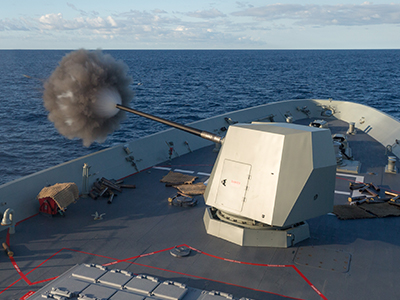Weapons that think and collaborate to defeat enemies

Defence Science Technology (DST) has formed a collaboration with partners from academia and industry to develop new weapons technology that will assist the Australian Defence Force (ADF) effectively defend assets and minimise collateral damage during targeted attacks.
The DST's Collaborative and Cognitive Weapons (C2W) Program led by Defence researcher Dr Ninh Duong is focused on tipping the scales in favour of the ADF for all future conflicts by changing the way targets are attacked and assets are defended.
Think about multiple weapons working together to defeat a target. They navigate together, share information about threats, distract and dazzle enemy systems before finally exploding around the target in a unique way which focuses the effects on the target and reduces collateral damage.
"This exciting new technology that we are developing for the ADF will provide the capability to neutralise the enemy while protecting friendly forces nearby," Duong explains.
"It's an ambitious program and we can't do it alone, so we need to reach out and work with academia and industry."
Reaping benefits from Partnerships Week
DST recently hosted a C2W workshop, inviting potential partners from academia and industry who were identified through networks and introductions made at Partnerships Week 2017.
"Through DST foundation programs such as C2W, the opportunities for collaboration with industry and academia have exploded. No pun intended," Defence researcher Dr Jeremy Anderson explains.
"Partnering with academia and industry is especially exciting as it allows us to tackle bigger challenges and provides a real transition path to turn the research into capability for the ADF."
Anderson says the major outcome of the workshop was an agreement on how to divide the problem up between the parties.
His team will take the lead on overall coordination and will also focus on warhead effects with the University of South Australia (UniSA); modelling the response of targets will be led by University of Sydney, and experimental validation of the target models will be led by the University of Wollongong in their new National Facility for Physical Blast Simulation. Flinders University will lead the development of new sensors for measuring the pressure of shock waves. Industry partner DefendTex will help shape the research to ensure there is an exploitation path to future weapons systems.
Building a unique sovereign capability
The first series of experiments to study the combined effects from multiple high explosive charges was conducted in DST's High Explosive Firing Complex in September 2017. The experiments characterised the interaction of shock waves from multiple charges, and the results will be used to validate predictive modelling tools.
DST researcher Steven Stojko, who leads the experimental aspects of the C2W activity, says the research will not only lead to new ways in which the ADF will be able to neutralise targets, but will also dramatically improve Australia's capability to defend against threats both on the battlefield and in a national security context.
"This area of research is so new that the sensors required to measure pressure of colliding shock waves don't exist yet," says Stojko.
"By working with Flinders University we hope to develop new sensors which can measure pressure from all directions without corrupting the flow field."

